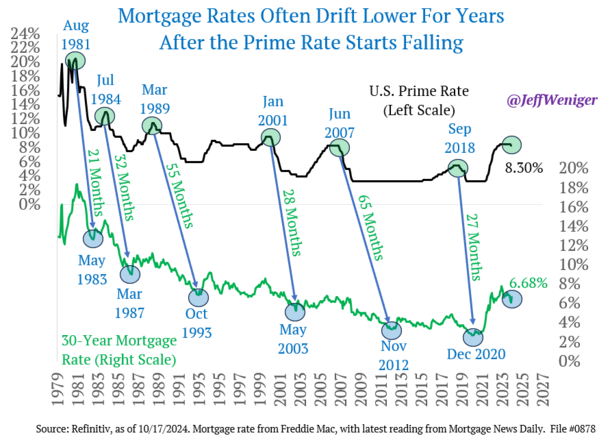In case you’ve been paying consideration, you could have observed that mortgage charges have quietly crept again as much as practically 7%.
Whereas it appeared that these 7% mortgage charges had been a factor of the previous, they appeared to return simply as shortly as they disappeared.
For reference, the 30-year fastened averaged round 8% a yr in the past, earlier than starting its descent to almost 6% in early September.
It appeared we had been destined for five% charges once more, then the Fed price reduce occurred. Whereas the Fed itself didn’t “do something,” their pivot coincided with some optimistic financial stories.
Mixed with a “promote the information” occasion of the Fed reduce itself, charges skyrocketed. Nevertheless, now may be time to remind you that charges do are inclined to fall for some time after price cuts start.
Falling Charges Typically Play Out Over Years, Not Months
As famous, the Fed pivoted, aka lowered its personal fed funds price, in September. They did so after rising their price 11 occasions throughout a interval of tightening.
Therefore the phrase “pivot,” as they swap from elevating charges to decreasing charges.
Briefly, the Fed decided financial coverage was sufficiently restrictive, and it was time to loosen issues up. This tends to lead to decrease borrowing charges over time.
Whereas many falsely assumed the pivot would result in even decrease mortgage charges in a single day, these “within the know” knew these cuts had been principally already baked in, no less than for now.
So when the Fed reduce, mortgage charges truly drifted just a little larger, although not by a lot. The actual transfer larger post-cut got here after a better-than-expected jobs report.
These days, unemployment has taken heart stage, and a sturdy labor report tends to level to a resilient financial system, which in flip will increase bond yields.
And since mortgage charges observe the 10-year bond yield very well, we noticed the 30-year fastened leap larger.
After practically hitting the high-5s in early September, it utterly reversed course and is now knocking on the 7% door once more.
How is that this potential? I assumed the excessive charges had been behind us. Nicely, as I wrote earlier this month, mortgage charges don’t transfer in a straight line up or down.
They will fall whereas they’re rising, and climb when they’re falling. For instance, there have been occasions once they moved down a whole share level throughout their ascent in 2022.
So why is it now shocking that they wouldn’t do the identical factor when falling? It shouldn’t be when you zoom out just a little, however most can’t keep the course and comprise their feelings from dramatic strikes like this.
It Can Take Three Years for Mortgage Charges to Transfer Decrease After a Fed Pivot

WisdomTree Head of Equities Jeff Weniger crafted a extremely attention-grabbing chart not too long ago that checked out how lengthy mortgage charges are inclined to fall after the prime price begins falling.
He graphed six cases when charges got here down from 1981 by 2020 after prime was lowered. And every time, aside from in 1981, it took no less than two years for charges to hit their cycle backside.
If we mix all these falling mortgage price intervals and use the common, it took 38 months for them to maneuver from peak to trough.
In different phrases, greater than three years for charges to hit their lowest level after an preliminary Fed reduce.
Because it stands now, we’re solely a month into the prime price falling. However it’s necessary to notice that charges had already fallen from round 8% a yr in the past.
They’ve now drifted again as much as round 6.875%, and it’s unclear in the event that they’ll proceed to maneuver larger earlier than coming down once more.
However the takeaway for me, in agreeing with Weniger, is that we stay in a falling price surroundings.
Even when 30-year fastened charges hit 7% once more, it’s decrease highs over time as charges proceed to descend.
Which means we noticed 8% in October, 7.5% in April, and maybe we’ll see 7% this month. However that’s nonetheless a .50% decrease price every time.
The following cease may very well be 6.5% once more, then 6%, then 5.5%. Nevertheless, it gained’t be a straight line down.
Nonetheless, it’s necessary to concentrate to the longer-term development, as a substitute of getting caught up within the day-to-day motion.
Mortgage Lenders Take Their Time Reducing Charges!
I’ve mentioned this earlier than and I’ll say it once more for the umpteenth time.
Mortgage lenders will all the time take their candy time decreasing charges, however gained’t hesitate in any respect when elevating them.
From their perspective, it makes excellent sense. Why would they stick their neck out unnecessarily? May as properly gradual play the decrease charges in the event that they’re unsure the place they’ll go subsequent.
As a lender, when you’re in any respect fearful charges will worsen, it’s finest to cost it in forward of time to keep away from getting caught out.
That’s possible what is going on now. Lenders are being defensive as regular and elevating their charges in an unsure financial surroundings.
If and once they see softer financial information and/or larger unemployment numbers, they’ll start decreasing charges once more.
However they’ll by no means be in any rush to take action. Conversely, even a single optimistic financial report, corresponding to the roles report that obtained us into this case, will likely be sufficient for them to lift charges.
In different phrases, we would want a number of delicate financial stories to see mortgage charges transfer meaningfully decrease, however only one for them to bounce larger.
So when you’re ready for decrease mortgage charges, be affected person. They’ll possible come, simply not as shortly as you’d anticipate.

